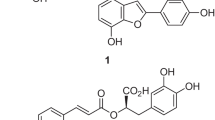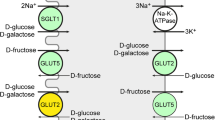Abstract
Haw pectin penta-oligogalacturonide (HPPS), purified from the hydrolysates of haw pectin, has important role in decreasing hepatic cholesterol accumulation and promoting bile acids (BA) excretion in the feces of mice fed a high-cholesterol diet (HCD). However, the mechanism is not clear. This study aims to investigate the effects of HPPS on BA reabsorption in ileum and biosynthesis in liver of mice. Results showed that HPPS increased fecal BA output by approximately 110%, but decreased ileal BA and the total BA pool size by approximately 47 and 36%, respectively, compared to HCD. Studies of molecular mechanism revealed that HPPS significantly decreased the mRNA and protein levels of farnesoid X receptor (FXR) in the small intestine of mice and inactivated the fibroblast growth factor 15 (FXR-FGF15) axis, which increased the mRNA and protein levels of CYP7A1 by approximately 204 and 104%, respectively, compared to HCD. Interestingly, the mRNA and protein levels of apical sodium-dependent bile acid transporter (ASBT) in the small intestine were approximately 128 and 73% higher in HPPS-fed mice than those in HCD-fed mice, respectively. However, no significant difference was detected for ASBT expression between HCD group and BA sequestrant cholestyramine group. These findings indicate that HPPS can suppress intestinal BA reabsorption and promoting hepatic BA biosynthesis. We speculated that HPPS could be ASBT competitive inhibitor rather than BA sequestrant in inhibiting BA reabsorption in ileum and improving cholesterol metabolism.




Similar content being viewed by others
Abbreviations
- HPPS:
-
Haw pectin penta-oligogalacturonide
- HCD:
-
High-cholesterol diet
- SD:
-
Standard diet
- CHO:
-
Cholestyramine
- TC:
-
Total cholesterol
- ASBT:
-
Apical sodium-dependent bile acid transporter
- IBABP:
-
Ileal bile acid binding protein
- OST:
-
Organic solute transporter
- FXR:
-
Farnesoid X receptor
- FGF:
-
Fibroblast growth factor
- FGFR4:
-
FGF receptor 4
- SHP1:
-
Short heterodimer partner 1
- MRP3:
-
Multidrug resistance-associated protein-3
- CYP7A1:
-
Cholesterol 7α-hydroxylase 1
References
Smet ED, Mensink RP, Plat J (2012) Effects of plant sterols and stanols on intestinal cholesterol metabolism: suggested mechanisms from past to present. Mol Nutr Food Res 56:1058–1072
He WS, Jia CS, Yang YB, Ma Y, Zhang XM, Feng B, Jin J (2011) Cholesterol-lowering effects of plant steryl and stanyl laurate by oral administration in mice. J Agric Food Chem 59:5093–5099
Baigent C, Blackwell L, Emberson J, Holland LE, Reith C, Bhala N, Peto R, Barnes EH, Keech A, Simes J, Collins R (2010) Efficacy and safety of more intensive lowering of LDL cholesterol: a meta-analysis of data from 170 000 participants in 26 randomised trials. Lancet 376:1670–1681
Chen W, Guo J-X, Chang P (2012) The effect of taurine on cholesterol metabolism. Mol Nutr Food Res 56:681–690
Hofmann AF, Hagey LR (2008) Bile acids: chemistry, pathochemistry, biology, pathobiology, and therapeutics. Cell Mol Life Sci 65:2461–2483
Dawson PA, Lan T, Rao A (2009) Bile acid transporters. J Lipid Res 50:2340–2357
Ballatori N, Christian WV, Lee JY, Dawson PA, Soroka CJ, Boyer JL, Madejczyk MS, Li N (2005) OSTα-OSTβ: a major basolateral bile acid and steroid transporter in human intestinal, renal, and biliary epithelia. Hepatology 42:1270–1279
Oelkers P, Dawson PA (1995) Cloning and chromosomal localization of the human ileal lipid-binding protein. Biochim Biophys Acta 1257:199–202
Pols TWH, Noriega LG, Nomura M, Auwerx J, Schoonjans K (2011) The bile acid membrane receptor TGR5 as an emerging target in metabolism and inflammation. J Hepatol 54:1263–1272
Sjövall J (2004) Fifty years with bile acids and steroids in health and disease. Lipids 39:703–722
Wang H, Chen J, Hollister K, Sowers LC, Forman BM (1999) Endogenous bile acids are ligands for the nuclear receptor FXR. Mol Cell 3:543–553
Janowski BA, Willy PJ, Devi TR, Falck JR, Mangelsdorf DJ (1996) An oxysterol signalling pathway mediated by nuclear receptor LXR alpha. Nature 383:728–731
Dawson PA, Hubbert ML, Rao A (2010) Getting the mOST from OST: role of organic solute transporter, OSTα-OSTβ, in bile acid and steroid metabolism. BBA-Mol Cell Biol L 1801:994–1004
Chau CF, Yang P, Yu CM, Yen GC (2008) Investigation on the lipid- and cholesterol-lowering abilities of biocellulose. J Agric Food Chem 56:2291–2295
Li T, Li S, Du L, Wang N, Guo M, Zhang J, Yan F, Zhang H (2010) Effects of haw pectic oligosaccharide on lipid metabolism and oxidative stress in experimental hyperlipidemia mice induced by high-fat diet. Food Chem 121:1010–1013
Marounek M, Volek Z, Skřivanová E, Tůma J (2010) Effects of amidated pectin alone and combined with cholestyramine on cholesterol homeostasis in rats fed a cholesterol-containing diet. Carbohyd Polym 80:989–992
Denman LJ, Morris GA (2015) An experimental design approach to the chemical characterisation of pectin polysaccharides extracted from Cucumis melo Inodorus. Carbohyd Polym 117:364–369
Wang N, Zhang CY, Qi YD, Li TP (2007) Extraction and food chemical characterizations of haw pectin. Sci Technol Food Ind 28:87–92 (in China)
Zhu RG, Li TP, Dong YP, Liu YH, Li SH, Chen G, Zhao ZS, Jia YF (2013) Pectin pentasaccharide from hawthorn (Crataegus pinnatifida Bunge. Var. major) ameliorates disorders of cholesterol metabolism in high-fat diet fed mice. Food Res Int 54:262–268
Li SH, Li TP, Jia YF, Zhu RG, Wang N, Jin S, Guo M (2011) Fractionation and structural characterization of haw pectin oligosaccharides. Eur Food Res Technol 233:731–734
Hoang MH, Houng SJ, Jun HJ, Lee JH, Choi JW, Kim SH, Kim YR, Lee SJ (2011) Barley intake induces bile acid excretion by reduced expression of intestinal ASBT and NPC1L1 in C57BL/6J mice. J Agric Food Chem 59:6798–6805
Bradford MM (1976) A rapid and sensitive method for the quantitation of microgram quantities of protein utilizing the principle of protein-dye binding. Anal Biochem 72:248–254
Dawson PA, Hubbert M, Haywood J, Craddock AL, Zerangue N, Christian WV, Ballatori N (2005) The heteromeric organic solute transporter α-β, Ostα-Ostβ, is an ileal basolateral bile acid transporter. J Biol Chem 280:6960–6968
Chiang JYL (2004) Regulation of bile acid synthesis: pathways, nuclear receptors, and mechanisms. J Hepatol 40:539–551
Ramirez MI, Carauglu D, Haro D, Barillas C, Bashirzadeh R, Gil G (1994) Cholesterol and bile acids regulate cholesterol 7 alpha-hydroxylase expression at the transcriptional level in culture and in transgenic mice. Mol Cell Biol 14:2809–2821
Nagano M, Kuroki S, Mizuta A, Furukawa M, Noshiro M, Chijiiwa K, Tanaka M (2004) Regulation of bile acid synthesis under reconstructed enterohepatic circulation in rats. Steroids 69:701–709
Kong B, Wang L, Chiang JYL, Zhang Y, Klaassen CD, Guo GL (2012) Mechanism of tissue-specific farnesoid X receptor in suppressing the expression of genes in bile-acid synthesis in mice. Hepatology 56:1034–1043
Degirolamo C, Rainaldi S, Bovenga F, Murzilli S, Moschetta A (2014) Microbiota modification with probiotics induces hepatic bile acid synthesis via downregulation of the Fxr-Fgf15 axis in mice. Cell Rep 7:12–18
Inagaki T, Choi M, Moschetta A, Peng L, Cummins CL, McDonald JG, Luo G, Jones SA, Goodwin B, Richardson JA, Gerard RD, Repa JJ, Mangelsdorf DJ, Kliewer SA (2005) Fibroblast growth factor 15 functions as an enterohepatic signal to regulate bile acid homeostasis. Cell Metab 2:217–225
Lan T, Rao A, Haywood J, Kock ND, Dawson PA (2012) Mouse organic solute transporter alpha deficiency alters FGF15 expression and bile acid metabolism. J Hepatol 57:359–365
Dawson PA, Haywood J, Craddock AL, Wilson M, Tietjen M, Kluckman K, Maeda N, Parks JS (2003) Targeted deletion of the ileal bile acid transporter eliminates enterohepatic cycling of bile acids in mice. J Biol Chem 278:33920–33927
Shneider BJ (2001) Intestinal bile acid transport: biology, physiology, and pathophysiology. J Pediatr Gastroenterol Nutr 32:407–417
Frankenberg T, Rao A, Chen F, Haywood J, Shneider BL, Dawson PA (2006) Regulation of the mouse organic solute transporter alpha–beta, Ostalpha–Ostbeta, by bile acids. Am J physiol-Gastr L 290:912–922
Kok T, Hulzebos CV, Wolters H, Havinga R, Agellon LB, Stellaard F, Shan B, Schwarz M, Kuipers F (2003) Enterohepatic Circulation of Bile Salts in Farnesoid X Receptor-deficient Mice: efficient intestinal bile salt absorption in the absence of ileal bile acid-binding protein. J Biol Chem 278:41930–41937
Acknowledgements
This work was supported by research grants from the National Natural Science Foundation of China (31301424/C200402); Foundation of Liaoning educational Committee (L2013008); The Doctoral Scientific Research Foundation of Liaoning University; Science and Technology Planning Project of Shenyang City, China (F16-205-1-52, F16-219-6-00).
Author information
Authors and Affiliations
Corresponding author
Ethics declarations
Conflict of interest
The authors declare no conflict of interests.
About this article
Cite this article
Zhu, R., Hou, Y., Sun, Y. et al. Pectin Penta-Oligogalacturonide Suppresses Intestinal Bile Acids Absorption and Downregulates the FXR-FGF15 Axis in High-Cholesterol Fed Mice. Lipids 52, 489–498 (2017). https://doi.org/10.1007/s11745-017-4258-x
Received:
Accepted:
Published:
Issue Date:
DOI: https://doi.org/10.1007/s11745-017-4258-x




